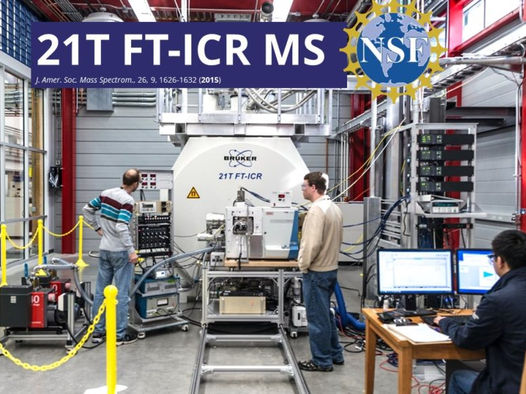Researchers develop new approach to discover pervasive ‘forever’ chemicals known as PFAS
Advanced mass spectrometry helps unravel complexity of PFAS chemistry
PFAS, a family of thousands of human-made chemicals, are everywhere, and some of them are known to be harmful for our bodies and the environment. Even more frightening is how little we know about these pervasive pollutants found in everything from food packaging and cleaning products to firefighting foams.

The 21 tesla Fourier-transform ion cyclotron resonance mass spectrometer (21T FT-ICR MS) at the NSF-funded National High Magnetic Field Lab is the most powerful, highest resolving machine of its kind. It uses electric and magnetic fields to distinguish individual molecules and can differentiate between chemical compounds more accurately than any other instrument.
Provided/National High Magnetic Field Lab
A team of researchers including Colorado State University’s Jens Blotevogel is using one of the most powerful chemical analysis tools in the world to unravel the complexities of PFAS. They are working to characterize and catalog the thousands upon thousands of chemical compounds in the PFAS family, so future studies can find solutions to health and environmental impacts.
“We’re not only attempting to resolve the chemical complexity of PFAS, we’re also opening doors for researchers who want to look at treatment, environmental fate and transport, and toxicology,” said Blotevogel, a research assistant professor in the Department of Civil and Environmental Engineering. “This is giving people the strongest possible magnifying glass to unravel these processes.”
PFAS require a closer look because we don’t even know how many there are. A study by Blotevogel and his collaborators published in Environmental Science and Technology in January found evidence that suggests there may be many more than the several thousand already identified.
A tight family
PFAS stands for per- and polyfluoroalkyl substances. Their signature carbon-fluorine chemical bond is among the strongest in nature, earning them the nickname, “forever chemicals.”
They persist in nature and in us. Studies have shown PFAS in the blood of people and animals all around the world.
“The first step is understanding what species are there, and then you can figure out the environmental impacts and try to remediate them, but you’ve got to know the chemistry,” said Amy McKenna, an affiliate faculty member of CSU’s Department of Soil and Crop Sciences and environmental analytical chemist at the NSF-funded National High Magnetic Field Laboratory in Tallahassee, Florida.
One-of-a-kind instrument
McKenna is well acquainted with the best tool for analyzing complex mixtures: the 21 tesla Fourier-transform ion cyclotron resonance mass spectrometer (21T FT-ICR MS) at the National High Magnetic Field Lab. Far from your typical scale, mass spectrometers use electric and magnetic fields to distinguish individual molecules, which weigh less than a trillionth of a trillionth of an ounce.
The MagLab’s advanced mass spectrometer is the most powerful, highest resolving machine of its kind. It can differentiate between individual chemical compounds more accurately than any other instrument.
“It’s powerful enough to be able to see all of these different PFAS molecules, but it’s also powerful enough to pick them out of environmental samples that contain many thousands of natural compounds,” said Robert Young, a CSU alumnus and director of the Chemical Analysis and Instrumentation Laboratory at New Mexico State University.
The samples analyzed for their recent study came from PFAS-contaminated sites, and each contained about 10,000 to 30,000 compounds – numerous human-made chemicals against a background of natural organic material. The MagLab’s unique instrument measures mass so precisely that the researchers can determine the elemental makeup for many compounds present.
Access to such a specialized instrument is limited, but the team is cataloging their findings in a database of PFAS compounds so others can utilize their results. They have published a PFAS library with a report detailing their new analytical method based on their work to date for the U.S. Department of Defense’s Strategic Environmental Research and Development Program.
“We want to leverage the power of ion cyclotron resonance to provide a service to the scientific community by establishing a catalog of PFAS compounds they can use as a tool to develop methods that don’t rely on the 21T FT-ICR MS,” McKenna said.
Shedding light on chemical dark matter
Most environmental investigations only look for about 15 to 30 well-known PFAS compounds, Blotevogel said, but there could be other potentially hazardous compounds lurking in the “dark matter” that we don’t see.
“What if there is a black swan among these unknowns?” he said.
The MagLab’s powerful mass spectrometer enables them to find the unknowns, determine their chemical formulas and log them for future research.
The researchers are interested not only in the composition of PFAS compounds, they also want to know how those compounds change in the environment. Some compounds may go from harmless to harmful when they degrade or are mixed with other compounds.
Only by understanding what the compounds are and what they become can we figure out whether they are hazardous and how to clean them up. First, we need to know what we’re looking for, and that’s where Blotevogel, McKenna, Young and their team are breaking new ground.
“The long-term goal is to help identify these things so other people know what to look for,” Young said. “As soon as we know what to look for, we can focus on understanding the health and environmental impacts, and prioritize treatment or regulatory solutions.”
Original publication
See the theme worlds for related content
Topic World Mass Spectrometry
Mass spectrometry enables us to detect and identify molecules and reveal their structure. Whether in chemistry, biochemistry or forensics - mass spectrometry opens up unexpected insights into the composition of our world. Immerse yourself in the fascinating world of mass spectrometry!

Topic World Mass Spectrometry
Mass spectrometry enables us to detect and identify molecules and reveal their structure. Whether in chemistry, biochemistry or forensics - mass spectrometry opens up unexpected insights into the composition of our world. Immerse yourself in the fascinating world of mass spectrometry!



























































